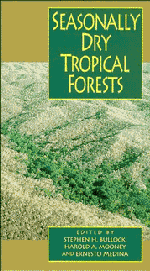Book contents
- Frontmatter
- Contents
- List of contributors
- Acknowledgements
- 1 Introduction
- 2 Dry forests of Central America and the Caribbean
- 3 Overview of the Brazilian caatinga
- 4 Savannas, woodlands and dry forests in Africa
- 5 Dry forest ecosystems of Thailand
- 6 The Cenozoic record of tropical dry forest in northern Latin America and the southern United States
- 7 Diversity and floristic composition of neotropical dry forests
- 8 Vertebrate diversity, ecology and conservation in neotropical dry forests
- 9 Diversity of life forms of higher plants in neotropical dry forests
- 10 Drought responses of neotropical dry forest trees
- 11 Plant reproduction in neotropical dry forests
- 12 Plant–herbivore interactions in Mesoamerican tropical dry forests
- 13 Biomass distribution and primary productivity of tropical dry forests
- 14 Nutrient cycling in tropical deciduous forests
- 15 Biology of the belowground system of tropical dry forests
- 16 Nitrogen trace gas emissions in a tropical dry forest ecosystem
- 17 Conversion of tropical dry forest to pasture and agriculture
- 18 Ethnobotany of the Mexican tropical dry forests
- Index
6 - The Cenozoic record of tropical dry forest in northern Latin America and the southern United States
Published online by Cambridge University Press: 07 September 2010
- Frontmatter
- Contents
- List of contributors
- Acknowledgements
- 1 Introduction
- 2 Dry forests of Central America and the Caribbean
- 3 Overview of the Brazilian caatinga
- 4 Savannas, woodlands and dry forests in Africa
- 5 Dry forest ecosystems of Thailand
- 6 The Cenozoic record of tropical dry forest in northern Latin America and the southern United States
- 7 Diversity and floristic composition of neotropical dry forests
- 8 Vertebrate diversity, ecology and conservation in neotropical dry forests
- 9 Diversity of life forms of higher plants in neotropical dry forests
- 10 Drought responses of neotropical dry forest trees
- 11 Plant reproduction in neotropical dry forests
- 12 Plant–herbivore interactions in Mesoamerican tropical dry forests
- 13 Biomass distribution and primary productivity of tropical dry forests
- 14 Nutrient cycling in tropical deciduous forests
- 15 Biology of the belowground system of tropical dry forests
- 16 Nitrogen trace gas emissions in a tropical dry forest ecosystem
- 17 Conversion of tropical dry forest to pasture and agriculture
- 18 Ethnobotany of the Mexican tropical dry forests
- Index
Summary
Introduction
The history of a plant community is reconstructed from remains preserved in a fragmentary fossil record. The completeness of the reconstructed community is, in part, a function of whether the community grew under conditions favorable to the preservation of macro- and microfossils. Macrofossil assemblages (leaves, fruits, seeds, wood) generally record plants growing near the site of deposition, and these afford opportunities to determine the general vegetation type and the paleoclimate by comparisons with modern analogs and by the use of leaf physiognomy. Microfossils (pollen, spores, trichomes, cuticles, phytoliths, microscopic organisms) provide a record of the regional vegetation, and also include species often not represented by macrofossils, such as annual, suffrutescent and herbaceous plants. Each methodology has its own set of strengths, weaknesses, practitioners and advocates, but the most complete history of plant communities is produced when both macro- and microfossil floras are available.
Northern Latin America
In the case of the tropical dry forest in northern Latin America, the reconstruction of its history is made more challenging by the facts that (1) dry environments have fewer sites of deposition, and less water for the transport of remains to these sites, and (2) there are very few well-preserved Tertiary macrofossil floras of significant size or diversity known for northern Latin America. An exception is the Oligocene San Sebastian flora from Puerto Rico, but it has not been studied or revised since Hollick's (1928) original publication.
- Type
- Chapter
- Information
- Seasonally Dry Tropical Forests , pp. 124 - 145Publisher: Cambridge University PressPrint publication year: 1995
- 29
- Cited by



